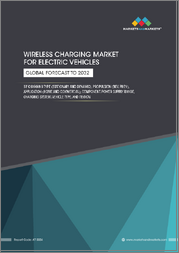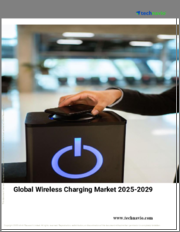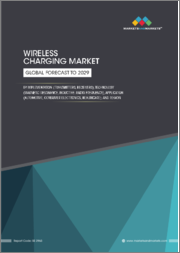
|
시장보고서
상품코드
1733236
세계의 무선 충전 시장 : 기술, 용도, 컴포넌트, 지역별(2026-2032년)Wireless Charging Market by Technology (Inductive, Resonant, Radiofrequency), Application (Consumer Electronics, Automotive, Industrial, Healthcare), Component (Receiver, Transmitter) and Region for 2026-2032 |
||||||
무선 충전 시장 평가, 2026-2032년
스마트폰, 태블릿, 스마트워치 및 기타 가전제품에 대한 수요 급증은 무선 충전 시장의 주요 촉진요인으로 작용하고 있습니다. 무선 충전 시장 규모는 2024년 94억 9,000만 달러를 돌파하고 2032년에는 약 406억 7,000만 달러에 달할 것으로 예측됩니다.
전기자동차 시장의 확대는 무선 충전 기술 수요에 크게 기여하고 있으며, 2026-2032년 연평균 22.00%의 연평균 복합 성장률(CAGR)을 보일 것으로 예측됩니다.
무선충전 시장 정의/개요
유도 충전으로도 알려진 무선 충전은 물리적 커넥터나 케이블 없이 충전소에서 호환되는 장치로 전기 에너지를 전송할 수 있는 기술입니다. 이 방식은 전자기 유도 원리를 기반으로 하며, 충전 패드 내의 코일에 교류 전류가 흐르면서 자기장이 발생합니다. 수신 코일이 장착된 기기를 충전 패드 근처에 놓으면 이 자기장에 의해 수신 코일에 전류가 유도되고, 이것이 직류 전류로 변환되어 기기의 배터리를 충전합니다.
무선 충전은 편리함과 사용 편의성 등 몇 가지 장점이 있습니다. 사용자는 케이블에 얽매이지 않고 충전 표면에 기기를 올려놓기만 하면 충전을 시작할 수 있기 때문입니다. 무선 충전은 스마트폰, 태블릿, 웨어러블 등 가전제품, 전기자동차, 의료기기 등에서 널리 사용되고 있습니다. 이 기술은 Qi와 같은 표준을 통해 진화하고 있으며, 서로 다른 기기와 제조업체 간의 호환성을 보장하고 있습니다. 효율성과 속도의 지속적인 발전으로 무선 충전은 가정에서 공공장소에 이르기까지 일상 생활에 점점 더 많이 통합되어 사용자 경험을 향상시키고 케이블 없는 라이프스타일을 촉진하고 있습니다.
스마트폰 및 웨어러블 기기의 채택 증가는 무선 충전 시장의 성장을 어떻게 촉진할 것인가?
스마트폰 및 웨어러블 기기의 보급이 무선 충전 시장의 큰 성장을 가속하고 있으며, 2023년 세계 무선 충전 시장은 약 134억 달러로 평가되었고, 2026-2032년 연평균 13.4% 성장하여 2032년에는 704억 달러에 달할 것으로 예측됩니다. 있을 것으로 예측되고 있습니다. 이러한 급격한 성장의 주요 요인은 소비자들 사이에서 편의성에 대한 수요가 증가하고 있으며, 현재 스마트폰의 80% 이상이 무선 충전 기능을 갖추고 있기 때문입니다. 지속 가능한 기술을 장려하는 정부의 이니셔티브도 이러한 추세에 힘을 실어주고 있으며, 무선 충전은 기존의 유선 방식을 대체할 수 있는 깨끗한 방법으로 인식되고 있습니다.
또한, 다양한 가전제품에 무선 충전 기술을 통합하여 사용자 경험을 개선하고 보급을 촉진하기 위해 주요 제조업체들이 적극적으로 추진하고 있으며, 2022년 시장 점유율의 45% 이상을 차지할 것으로 예상되는 아시아태평양에서는 급속한 도시화와 중산층 인구 증가로 인해 무선 충전 기능이 탑재된 스마트홈 및 사물인터넷(IoT) 기기에 대한 수요가 증가하고 있습니다. 무선 충전 기능이 탑재된 스마트홈 및 사물인터넷(IoT) 기기 수요 증가에 기여하고 있습니다. 전자 폐기물을 줄이고 에너지 효율적인 솔루션을 촉진하기 위한 정부 정책의 일관성은 시장 성장을 더욱 촉진할 것으로 예측됩니다.
무선 충전 기술의 효율성에 영향을 미치는 주요 기술적 한계는 무엇인가?
무선 충전 기술의 효율은 몇 가지 기술적 한계에 의해 크게 영향을 받습니다. 가장 큰 문제 중 하나는 충전 과정에서 발생하는 에너지 손실로, 기존 유선 방식에 비해 7-12% 더 높을 수 있으며, 2020년에 실시된 분석에 따르면 무선으로 스마트폰을 충전할 때 유선 충전보다 39% 더 많은 에너지를 소비하는 것으로 나타났습니다. 기술 특유의 비효율성을 강조하고 있습니다.
또한, 송신기와 수신기 코일 사이의 거리가 중요한 역할을 합니다. 이 거리가 길어질수록 효율성이 떨어지기 때문에 최적의 성능을 위해 정확한 정렬이 필요합니다. 정부 조사에 따르면, 이러한 비효율성은 충전 시간이 길어지고 운영 비용이 증가하는 경우가 많기 때문에 소비자들이 무선 충전 솔루션의 채택을 주저하게 만드는 요인으로 작용하고 있습니다. 또한, 무선 충전 중 발생하는 과도한 열은 배터리 수명에 악영향을 미칠 수 있으며, 이는 다양한 응용 분야에서의 보급과 사용을 더욱 복잡하게 만듭니다.
목차
제1장 세계의 무선 충전 시장 서론
- 시장 개요
- 조사 범위
- 전제조건
제2장 주요 요약
제3장 VERIFIED MARKET RESEARCH의 조사 방법
- 데이터 마이닝
- 밸리데이션
- 1차 자료
- 데이터 소스 리스트
제4장 세계의 무선 충전 시장 전망
- 개요
- 시장 역학
- 성장 촉진요인
- 성장 억제요인
- 기회
- Porter's Five Forces 모델
- 밸류체인 분석
제5장 세계의 무선 충전 시장 : 용도별
- 개요
- 자동차
- 가전
- 스마트폰
- 태블릿
- 웨어러블
- 노트북
- 기타
- 산업
- 자동화 및 로보틱스
- 자재관리
- 기타
- 헬스케어
- 의료기기
- 환자 모니터링
- 기타
- 항공우주 및 방위
- 기타
제6장 세계의 무선 충전 시장 : 기술별
- 개요
- 유도형
- 공진식
- 고주파(RF)
제7장 세계의 무선 충전 시장 : 컴포넌트별
- 리시버
- 트랜스미터
제8장 세계의 무선 충전 시장 : 지역별
- 개요
- 북미
- 미국
- 캐나다
- 멕시코
- 유럽
- 독일
- 영국
- 프랑스
- 기타 유럽
- 아시아태평양
- 중국
- 일본
- 인도
- 기타 아시아태평양
- 세계 기타 지역
- 라틴아메리카
- 중동 및 아프리카
제9장 세계의 무선 충전 시장 경쟁 구도
- 개요
- 기업의 시장 순위
- 주요 개발 전략
제10장 기업 개요
- Samsung Electronics Co., Ltd.
- Apple Inc.
- LG Electronics Inc.
- Energous Corporation
- Ossia Inc.
- Witricity Corporation
- Xiaomi Corporation
- Overview
- Financial Performance
- Product Outlook
- Key Developments
- Oppo Mobile Telecommunications Corp., Ltd.
- Vivo Mobile Communication Co., Ltd.
- Powermat Technologies Ltd.
제11장 부록
- 관련 조사
Wireless Charging Market Valuation - 2026-2032
The surge in demand for smartphones, tablets, smartwatches, and other consumer electronics is a major driver for wireless charging market . The wireless charging market is projected to size surpass USD 9.49 Billion valued in 2024 to reach a valuation of around USD 40.67 Billion by 2032.
The expansion of the electric vehicle market is significantly contributing to the demand for wireless charging technologies, is enabling the market grow at a CAGR of 22.00% from 2026 to 2032.
Wireless Charging Market: Definition/ Overview
Wireless charging, also known as inductive charging, is a technology that enables the transfer of electrical energy from a charging station to a compatible device without the need for physical connectors or cables. This method operates on the principle of electromagnetic induction, where an alternating current flows through a coil in the charging pad, generating a magnetic field. When a device equipped with a receiver coil is placed near the charging pad, this magnetic field induces an electric current in the receiver coil, which is then converted into direct current to charge the device's battery.
Wireless charging offers several advantages, including convenience and ease of use, as users can simply place their devices on a charging surface to initiate charging without fumbling with cables. It is widely used in consumer electronics such as smartphones, tablets, and wearables, as well as in electric vehicles and medical devices. The technology has evolved with standards like Qi, which ensures compatibility across different devices and manufacturers. With ongoing advancements in efficiency and speed, wireless charging is becoming increasingly integrated into everyday environments, from homes to public spaces, enhancing user experience and promoting a cable-free lifestyle.
How does the Increasing Adoption of Smartphones and Wearable Devices Drive Growth in the Wireless Charging Market?
The increasing adoption of smartphones and wearable devices is driving significant growth in the wireless charging market. In 2023, the global wireless charging market was valued at approximately USD 13.4 billion and is projected to grow at a compound annual growth rate (CAGR) of 13.4% from 2026 to 2032, potentially reaching USD 70.4 billion by 2032. This surge is largely attributed to the rising demand for convenience among consumers, as over 80% of smartphones now feature wireless charging capabilities. Government initiatives promoting sustainable technologies further support this trend, as wireless charging is recognized as a cleaner alternative to traditional wired methods.
Moreover, the integration of wireless charging technology into various consumer electronics is being actively pursued by leading manufacturers, enhancing user experience and encouraging adoption. In the Asia Pacific region, which accounted for over 45% of the market share in 2022, rapid urbanization and a growing middle-class population are contributing to increased demand for smart home and Internet of Things (IoT) devices that incorporate wireless charging functionalities. This alignment with government policies aimed at reducing electronic waste and promoting energy-efficient solutions is expected to further boost market growth.
What are the Major Technical Limitations Affecting the Efficiency of Wireless Charging Technology?
The efficiency of wireless charging technology is significantly affected by several technical limitations. One major issue is the energy loss during the charging process, which can be as high as 7-12% compared to traditional wired methods. An analysis conducted in 2020 found that charging a smartphone wirelessly consumed 39% more energy than wired charging, highlighting the inefficiency inherent in this technology.
Additionally, the distance between the transmitter and receiver coils plays a critical role; as this distance increases, efficiency decreases, necessitating precise alignment for optimal performance. Government studies have indicated that these inefficiencies contribute to consumer hesitance in adopting wireless charging solutions, as they often result in longer charging times and increased operational costs. Furthermore, the generation of excess heat during wireless charging can negatively impact battery longevity, further complicating widespread adoption and use in various applications.
Category-Wise Acumens
What Key Features of Inductive Technology Make it the Most Widely Adopted in Wireless Charging?
Inductive technology is widely adopted in wireless charging due to several key features that enhance its efficiency and usability. This method operates on the principle of electromagnetic induction, where electrical energy is transferred between two coils-one in the charging station and another in the device-through an alternating magnetic field. The Qi standard, which is the most recognized for inductive charging, allows for a close coupling between these coils, minimizing energy loss during the charging process. It has been reported that inductive charging can achieve efficiencies of up to 90% under optimal conditions.
Additionally, alignment tolerance is a significant advantage, as it permits users some flexibility in placing their devices on charging pads without precise alignment. Safety features are also integrated, ensuring proper communication between the charger and device to prevent overheating. These attributes contribute to the widespread adoption of inductive technology across various consumer electronics, including smartphones and wearables.
What Advantages of Receiver Components Contribute to their Dominant Role in the Wireless Charging Market?
The dominant role of receiver components in the wireless charging market is significantly attributed to several advantages that enhance their performance and efficiency. Advanced receiver designs are capable of achieving energy conversion efficiencies of up to 90%, which is crucial for effective wireless power transfer.
Additionally, the cost-effectiveness of receiver components has been noted, with manufacturing expenses having decreased by approximately 30% over the past five years. Government initiatives promoting wireless charging technology have further bolstered the market, with countries like South Korea investing over USD 1 Billion in wireless charging infrastructure development. The versatility and adaptability of receiver components to different charging standards are also recognized as significant contributors to their market dominance.
Country/Region-wise Acumens
What Role does Consumer Preference for Innovative and Convenient Charging Solutions Play in North America's Dominance in the Wireless Charging Market?
Consumer preference for innovative and convenient charging solutions plays a crucial role in North America's dominance in the wireless charging market. The region accounted for over 34% of the global market share in 2023, driven by a robust consumer electronics industry and high adoption rates of wireless charging-enabled devices. Government studies have highlighted that the widespread use of smartphones, tablets, and wearables featuring wireless charging capabilities has significantly boosted demand. For instance, the number of smart wearable device users in the U.S. increased from 20% of the population in 2021 to approximately 25% in 2022, with projections indicating further growth. This trend reflects a strong consumer inclination toward seamless and efficient charging experiences.
Moreover, major technology companies based in North America, such as Apple and Qualcomm, have heavily invested in promoting wireless charging technologies, which has accelerated market growth. The integration of wireless charging into electric vehicles is also being actively pursued, with significant investments expected to reach around USD 860 Billion by 2030 for EV infrastructure development. This alignment with consumer preferences for convenience and sustainability is expected to further solidify North America's leadership position in the wireless charging market, as innovative solutions continue to be developed and adopted across various sectors.
In What Ways do Government Initiatives and Investments in Technology Infrastructure Support the Growth of the Wireless Charging Market in Asia-Pacific?
Government initiatives and investments in technology infrastructure are significantly supporting the growth of the wireless charging market in the Asia-Pacific region. In 2020, China announced subsidies amounting to USD 1.4 Billion for the installation of charging stations, which has facilitated the development of necessary infrastructure for electric vehicles (EVs). Additionally, India allocated USD 486 Million in 2021 to promote the adoption of electric buses, further enhancing the charging network. Such government support is expected to create a conducive environment for wireless charging technologies, as these initiatives encourage manufacturers to integrate wireless solutions into their products.
Moreover, various countries in the region are implementing policies aimed at promoting sustainable energy solutions. For instance, South Korea has offered subsidies for installing EV charging stations, while Taiwan announced incentives up to TWD 300,000 (approximately $10,141) for public charging installations. These efforts are projected to drive the wireless charging market's growth at a CAGR of 40% during 2020-2025, reflecting the positive impact of government initiatives on technological advancements and infrastructure development.
Competitive Landscape
The competitive landscape of the Wireless Charging Market is characterized by the presence of several established players and emerging companies vying for market share. Key players in this market include technology giants, consumer electronics manufacturers, and specialized wireless charging solution providers. These players are engaged in various strategies, such as product innovation, strategic partnerships, and mergers and acquisitions, to strengthen their market position and gain a competitive edge.
Some of the prominent players operating in the wireless charging market include:
- Samsung Electronics Co., Ltd.
- Apple, Inc.
- LG Electronics, Inc.
- Energous Corporation
- Ossia, Inc.
- Witricity Corporation
- Xiaomi Corporation
- Oppo Mobile Telecommunications Corp. Ltd.
- Vivo Mobile Communication Co., Ltd.
- Powermat Technologies Ltd.
Latest Developments
- In February 2023, Samsung introduced the SmartThings Hub, which combines a wireless charger with a smart home automation controller. This innovative device not only facilitates the charging of Galaxy phones but also acts as a central hub for managing various smart home devices, thereby enhancing user convenience and promoting the adoption of wireless charging technology.
- In January 2023, Ossia introduced the Cota Forever Magnetic Phone Charger at CES 2024, which was recognized as a CES Innovation Awards winner. This charger enables wireless charging for mobile devices equipped with Qi2 and MagSafe technology, utilizing Ossia's patented Cota(R) Real Wireless Power(TM). The device allows users to charge their phones continuously without cords or pads, providing a truly wireless experience. This innovation reflects Ossia's commitment to addressing consumer pain points related to mobile charging.
Wireless Charging Market, By Category
- Technology:
- Inductive
- Resonant
- Radiofrequency (RF)
- Application:
- Consumer Electronics
- Automotive
- Industrial
- Healthcare
- Component:
- Receiver
- Transmitter
- Region:
- North America
- Europe
- Asia-Pacific
- Latin America
- Middle East & Africa
TABLE OF CONTENTS
1 INTRODUCTION OF GLOBAL Wireless Charging Market
- 1.1 Overview of the Market
- 1.2 Scope of Report
- 1.3 Assumptions
2 EXECUTIVE SUMMARY
3 RESEARCH METHODOLOGY OF VERIFIED MARKET RESEARCH
- 3.1 Data Mining
- 3.2 Validation
- 3.3 Primary Interviews
- 3.4 List of Data Sources
4 GLOBAL Wireless Charging Market OUTLOOK
- 4.1 Overview
- 4.2 Market Dynamics
- 4.2.1 Drivers
- 4.2.2 Restraints
- 4.2.3 Opportunities
- 4.3 Porters Five Force Model
- 4.4 Value Chain Analysis
5 GLOBAL Wireless Charging Market, BY APPLICATION
- 5.1 Overview
- 5.2 Automotive
- 5.3 Consumer Electronics
- 5.3.1 Smartphones
- 5.3.2 Tablets
- 5.3.3 Wearables
- 5.3.4 Laptops
- 5.3.5 Others
- 5.4 Industrial
- 5.4.1 Automation & Robotics
- 5.4.2 Material Handling
- 5.4.3 Others
- 5.5 Healthcare
- 5.5.1 Medical Devices
- 5.5.2 Patient Monitoring
- 5.5.3 Others
- 5.6 Aerospace & Defense
- 5.7 Other
6 GLOBAL Wireless Charging Market, BY TECHNOLOGY
- 6.1 Overview
- 6.2 Inductive
- 6.3 Resonant
- 6.4 Radiofrequency (RF)
7 GLOBAL Wireless Charging Market, BY COMPONENT
- 7.1 Receiver
- 7.2 Transmitter
8 GLOBAL Wireless Charging Market, BY GEOGRAPHY
- 8.1 Overview
- 8.2 North America
- 8.2.1 U.S.
- 8.2.2 Canada
- 8.2.3 Mexico
- 8.3 Europe
- 8.3.1 Germany
- 8.3.2 U.K.
- 8.3.3 France
- 8.3.4 Rest of Europe
- 8.4 Asia Pacific
- 8.4.1 China
- 8.4.2 Japan
- 8.4.3 India
- 8.4.4 Rest of Asia Pacific
- 8.5 Rest of the World
- 8.5.1 Latin America
- 8.5.2 Middle East & Africa
9 GLOBAL Wireless Charging Market COMPETITIVE LANDSCAPE
- 9.1 Overview
- 9.2 Company Market Ranking
- 9.3 Key Development Strategies
10 COMPANY PROFILES
- 10.1 Samsung Electronics Co., Ltd.
- 10.1.1 Overview
- 10.1.2 Financial Performance
- 10.1.3 Product Outlook
- 10.1.4 Key Developments
- 10.2 Apple Inc.
- 10.2.1 Overview
- 10.2.2 Financial Performance
- 10.2.3 Product Outlook
- 10.2.4 Key Developments
- 10.3 LG Electronics Inc.
- 10.3.1 Overview
- 10.3.2 Financial Performance
- 10.3.3 Product Outlook
- 10.3.4 Key Developments
- 10.4 Energous Corporation
- 10.4.1 Overview
- 10.4.2 Financial Performance
- 10.4.3 Product Outlook
- 10.4.4 Key Developments
- 10.5 Ossia Inc.
- 10.5.1 Overview
- 10.5.2 Financial Performance
- 10.5.3 Product Outlook
- 10.5.4 Key Developments
- 10.6 Witricity Corporation
- 10.6.1 Overview
- 10.6.2 Financial Performance
- 10.6.3 Product Outlook
- 10.6.4 Key Developments
- 10.7 Xiaomi Corporation
- 10.81 Overview
- 10.82 Financial Performance
- 10.83 Product Outlook
- 10.84 Key Developments
- 10.8 Oppo Mobile Telecommunications Corp., Ltd.
- 10.8.1 Overview
- 10.8.2 Financial Performance
- 10.8.3 Product Outlook
- 10.8.4 Key Developments
- 10.9 Vivo Mobile Communication Co., Ltd.
- 10.10.1 Overview
- 10.10.2 Financial Performance
- 10.10.3 Product Outlook
- 10.10.4 Key Developments
- 10.10 Powermat Technologies Ltd.
- 10.10.1 Overview
- 10.10.2 Financial Performance
- 10.10.3 Product Outlook
- 10.10.4 Key Developments
11 Appendix
- 11.1 Related Research



















